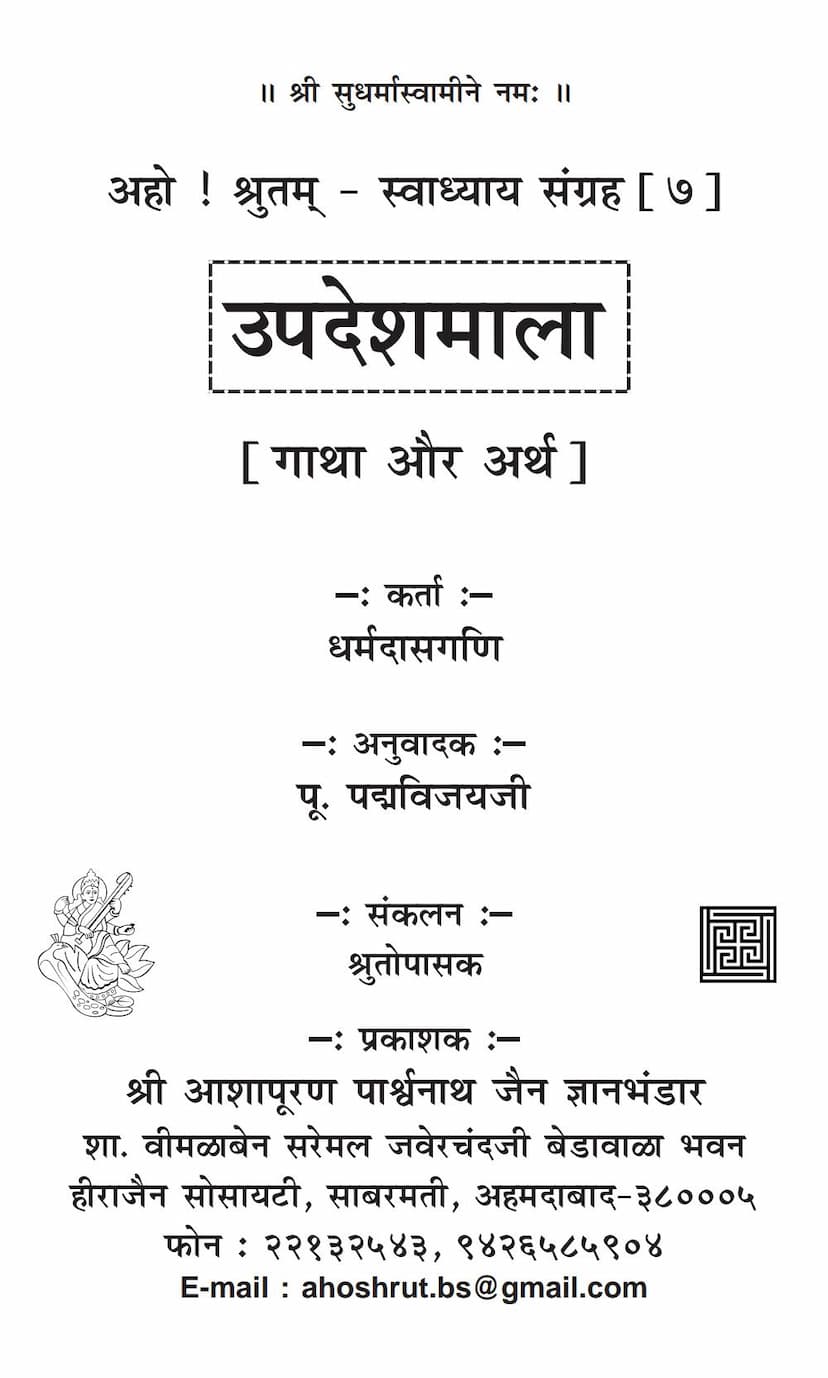Updeshmala
Added to library: September 2, 2025

Summary
Here is a comprehensive summary of the Jain text "Updeshmala" by Dharmdas Gani, based on the provided text:
Updeshmala: A Collection of Teachings for Spiritual Growth
"Updeshmala" (उपदेशमाला), authored by Dharmdas Gani and translated by Poojya Padmavijayji, is a compilation of verses offering profound spiritual and ethical guidance rooted in Jain philosophy. The text serves as a manual for seekers, covering a wide range of topics essential for spiritual progress, moral conduct, and understanding the path to liberation (moksha).
Core Themes and Content:
The Updeshmala expounds on various aspects of Jainism, emphasizing the importance of:
- Veneration of Tirthankaras and Gurus: The text begins with salutations to the Tirthankaras and respected gurus, highlighting their role as guides in the three worlds and venerated by celestial beings and kings. It underscores the necessity of listening to their teachings with humility and reverence.
- Exemplary Lives of Spiritual Leaders: It draws upon the lives of prominent figures like Rishabhdev and Mahavir Swami, illustrating their ascetic practices, resilience in the face of hardships (upasaraga), and unwavering devotion to their spiritual path. The example of Gautam Swami, the first Ganadhara, demonstrates the importance of attentive listening and humility even for the most learned.
- Qualities of an Ideal Acharya (Guru): The text elaborates on the characteristics of a true spiritual teacher, describing them as having a form like the Tirthankaras, being radiant, possessing wisdom, speaking sweetly, being profound, stable, and dedicated to imparting teachings. They are also described as compassionate, gentle, collected, resolute, and possessing deep wisdom.
- The Importance of Humility and Discipline: Numerous verses highlight the virtue of humility, illustrated by the example of Aryā Chandanbala, who remained humble despite her position. The text stresses that even a newly initiated monk should be shown respect by a seasoned nun, and vice versa, emphasizing the paramount importance of vinaya (respectful conduct).
- The True Nature of Dharma and the Role of Renunciation: It clarifies that dharma is not about outward appearances but inner purity and righteous conduct. The text advocates for renunciation of worldly possessions and desires, illustrating that true fulfillment lies not in material wealth but in spiritual pursuits.
- The Cycle of Birth and Death (Samsara): The Updeshmala extensively describes the suffering inherent in the cycle of birth and death, urging readers to understand the impermanence of worldly pleasures and the inevitability of death. It warns against attachment to fleeting worldly joys and the consequences of unwholesome karma.
- Karma and its Consequences: The text elaborates on how actions (karma) lead to consequences, shaping one's destiny across lifetimes. It emphasizes that one's deeds are the sole determinants of their fate, irrespective of birth or status.
- The Dangers of Attachments and Vices: It critically examines the detrimental effects of various vices such as pride, anger, deceit, greed, lust, and attachment to worldly pleasures. These are depicted as obstacles to spiritual progress and causes of suffering.
- The Practice of Austerity and Self-Control: The text champions the practice of austerities (tapas) and self-control (samyama) as essential tools for purifying the soul and overcoming karmic obstacles. It provides examples of ascetics who achieved spiritual heights through rigorous practices.
- The Significance of Ethical Conduct (Shila): It outlines the importance of maintaining ethical conduct, refraining from harming living beings, speaking truth, practicing non-stealing, chastity, and detachment.
- The Role of Knowledge and Righteous Conduct: The text stresses that mere knowledge without righteous conduct is futile. True liberation is achieved through the combined practice of right faith (samyak darshan), right knowledge (samyak jnan), and right conduct (samyak charitra).
- The Dangers of Wrong Associations and Influences: It warns against the company of the wicked, the allure of sensual pleasures, and straying from the righteous path, illustrating how these can lead to spiritual downfall.
- The Duties of a Jain Householder (Shravaka): The latter part of the text details the virtues and practices of an ideal Jain householder, including their adherence to vows, service to monks, generosity, ethical business practices, and devotion to the Jain path.
- The Superiority of Spiritual Renunciation over Worldly Pursuits: Through numerous stories and allegories, the Updeshmala consistently reinforces the message that true happiness and lasting peace are found in spiritual renunciation and the pursuit of liberation, not in worldly pleasures and possessions.
- The Importance of Faith and Devotion: It highlights the power of unwavering faith and devotion to the principles of Jainism, the Tirthankaras, and the spiritual guides.
Structure and Style:
The Updeshmala is composed of verses (Gathas) in Prakrit, each followed by its explanation in Hindi. This format makes the profound teachings accessible to a wider audience. The verses are often illustrative, drawing upon stories and examples from Jain tradition to convey complex spiritual concepts.
Overall Message:
The Updeshmala serves as a comprehensive guide for spiritual aspirants, offering practical advice and profound wisdom to navigate the complexities of life and the spiritual path. It encourages diligence, perseverance, humility, and unwavering adherence to the Jain principles of non-violence, truthfulness, non-stealing, chastity, and non-possession, ultimately aiming at the attainment of liberation.